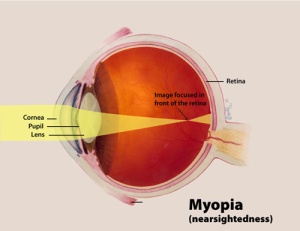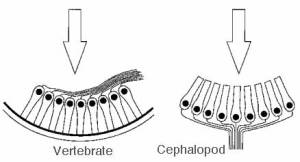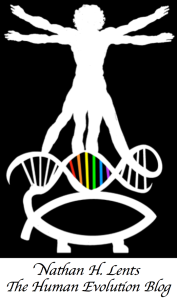The human eye is a well-tread example of how evolution can produce a clunky design even when the result is a well-performing anatomical product. The human eye is indeed a marvel, but if it were to be designed from scratch, it’s hard to imagine it would look anything like it does. Inside the human eye is the long legacy of how light-sensing slowly and incrementally developed in the animal lineage.
[Update: This article is now included as a section in my new book, Human Errors, go check it out!]
Not long ago, creationists often pointed to the human eye as an example of so-called irreducible complexity. Their claim was that the eye is so sophisticated, and with so many interconnected parts, that evolution could not have produced it through incrementation. Because the human eye does not function, even slightly, unless all of the parts are in place and working, there is no conceivable prior step of less complexity that the current form of the eye could have evolved from. So goes the complaint.
This bizarre objection misunderstands both how evolution works and how the eye works. It’s true that the eye won’t function if you remove any one part, but evolution doesn’t work by adding individual fully-formed parts to a pre-existing structure. The entire eye evolves as a unit.
There have been incremental advances throughout the entire structure of the eye, one at a time. Fortunately, we have many very good examples of earlier versions of the vertebrate eye, both from extant (living) organisms with more primitive eyes, and from the fossil record. In fact, the eye is now one of the anatomical structures about which we have the most complete understanding of its gradual evolution.
For this reason, creationists have largely abandoned the argument of irreducible complexity of the eye, retreating to more obscure examples such as the bacterial flagellum.
Before I discuss the puzzling physical design of the eye, let’s start off by making one thing clear: the human eye is fraught with functional problems as well.
Many people reading this are doing so only with the aid of modern technology. In the US and Europe, 30-40% of the population have myopia (near-sightedness) and require assistance from glasses or contact lenses. Otherwise, their eyes cannot focus light properly and cannot resolve objects that are more than a few feet away. The rate of myopia increases to more than 70% in Asian countries.
The defect in the myopic eye is not caused by injury or overuse: it is simply too long. Images focus sharply before they reach the back of the eye and then fall out of focus again as they finally land on the retina. It’s bad design, plain and simple.
Of course, the opposite problem, far-sightedness, exists as well and comes in two forms: hyperopia and presbyopia. Hyperopic eyes are built too short and the light fails to focus before hitting the retina, another example of poor construction.
Presbyopia, on the other hand, is age-related far-sightedness caused by the progressive loss of the flexibility of the lens and/or failure of the ciliary muscles to pull on the lens and focus light properly. Presbyopia literally means “old man sight” and begins to set in around age 40. By 60 years of age, virtually everyone suffers from difficulty resolving close objects. At 37 years old, I have already noticed that I hold books and newspapers further and further from my face as time goes on. The time for bifocals is nigh.
Add to this: glaucoma, cataracts, and retinal detachment (just to name a few), and a pattern begins to emerge. For the “most highly evolved creatures” on the planet, our eyes are rather lacking.
The vast majority of people will suffer significant loss of visual function in their lifetimes, and for many people, it starts even before puberty. I got glasses after my first eye exam when I was in the second grade. Who knows how long I had actually needed them? My vision isn’t just a little blurry; it’s terrible. My lenses are -4.25 diopters, which means my vision is somewhere around 20/400. Had I been born before, say, 1600, I would probably have gone through life unable to do anything that required me to see further than arm’s length. In pre-history, I would have been worthless as a hunter. Or a gatherer, for that matter.
Compare this to the excellent vision of most birds, especially birds of prey, such as eagles and condors. Their visual acuity at great distances puts even the best human eyes to shame. Many birds can see a broader range of wavelengths than we can also, including ultraviolet light. In fact, migrating birds detect north and south poles with their eyes. It’s not clear if they are consciously aware of this perception, but it seems likely to me that they are, considering this information is conveyed by the same nerves that relay vision. This would mean that some birds can actually see the earth’s magnetic field.
Many birds also have an additional translucent eyelid that allows them to look directly into the sun, at length, without damaging their retinas.
The superiority of the bird eye shows that whatever designed the human eye, be it nature or a deity, is capable of producing eyes that are much better than the human eye. The question of why nature didn’t provide humans with better eyes is easily answered by evolutionary theory: it wasn’t strongly selected for. Alternatively, why an intelligent designer would deny his favorite creatures the excellent vision that he provided lowly birds is quite a mystery.
There is more to be said about the shortcomings of our eyes. Our night-vision is, at best, only so-so, and for some it is very poor. Compare this to cats, whose night-vision is legendary. So sensitive are cats’ eyes that they can detect a single photon of light in an absolutely dark environment. For reference, in a small brightly lit room, there are about one hundred billion photons at any one moment in time.
Even with what light we can see, our acuity and resolution in dim light is far worse than that of cats, dogs, birds, and many other animals. You might be able to see more colors than dogs can, but they can see at night more clearly than you can.
Speaking of color vision, not all humans have that, either. Somewhere around 6% of the men in the world have some form of color blindness. (It’s not nearly as common in females because the screwed up genes that lead to color blindness are almost always on the X chromosome. Because they have two X chromosomes, females have a backup in case they inherit one bum copy). With a world population of around 7 billion, that means at least a quarter of a billion people cannot appreciate the same palette of colors that the rest of us can. That’s a lot of color blindness.
Now on to the physical design of the eye. One of the all-time most famous examples of quirky designs in nature is the vertebrate retina. The photoreceptor cells of the retina appear to be placed backward, with the wiring facing the light and the photoreceptor facing inward. A photoreceptor cells looks something like a microphone: the “hot” end has the sound receiver, and the other end terminates with the cable that carries the signal off to the amplifier. The human retina, located in the back of the eyeball, is designed such that all of the little “microphones” are facing the wrong way. The side with the cable faces forwards!
(I’m pretty sure this is photoshopped, but the point is made.)
This is not an optimal design for obvious reasons. The photons of light must travel around the bulk of the photoreceptor cell in order to hit the receiver tucked in the back. It’s as if you were speaking into the wrong end of a microphone. It can still work, provided that you turn the sensitivity of the microphone way up and you speak loudly.
Furthermore, light must travel through a thin layer of tissue and blood supply before reaching the photoreceptors.
To date, there are no working hypotheses about why the vertebrate retina is wired in backwards. It seems to have been a random development that then “stuck” because a correction of that magnitude would be very difficult to pull off with random mutations.
Interestingly, the retina of cephalopods – octopi and squid – is not inverted. The cephalopod eye and the vertebrate eye, while strikingly similar, evolved completely independently of one another. Nature “invented” the camera-like eye at least twice, once in vertebrates and once in cephalopods. (Insects, arachnids, and crustaceans have an entirely different type of eye.) During the evolution of the cephalopod eye, the retina took shape in a more logical way, with the photoreceptors facing outward toward the light. Vertebrates were not so lucky.
To be sure, evolution has done an impressive job of building an excellent eye despite the backwards contour of the retina. Perhaps capitalizing on the odd design, the vertebrate retina is able to provide oxygen and nutrients directly to the most metabolically active part of the light-sensing cells – the photoreceptors themselves.
However, there is no evidence that the backwards design is necessary or even advantageous for oxygen delivery, especially given that the cephalopod eye does not show any sign of inadequate oxygen delivery. While the blood vessels of the vertebrate retina have clearly made the best of a bad situation, all available evidence supports the notion that the inverted vertebrate retina is inferior to the more logical design of the cephalopods.
In fact, most ophthalmologists agree that the backwards retina is what causes retinal detachment to be more common in vertebrates than it is in cephalopods.
There is one more design quirk in the human eye that merits mention. Right smack in the middle of the retina, there is a structure called the optic disc where the axons of the millions of photoreceptor cells all converge to form the optic nerve. The disc is located on the surface of the retina, occupying a small circular spot in which no photoreceptor cells can fit.

This creates a blind spot in each eye. We don’t notice these blind spots because having two eyes compensates and our brain fills in the picture for us, but they are definitely there. You can find simple demonstrations of this on the internet by searching for “optic disc blind spot.”
The optic disc is a necessary structure insofar as the retinal axons must all converge at some point. An intelligent design would be to place it deeper in the back of the eye, tucked underneath the retina, rather than smack on top of it. The backwards placement of the retina makes the blind spot somewhat unavoidable and all vertebrates have it. Cephalopods do not, however, because their right-side-out retina allows the easy placement of the fovea behind an unbroken retina.
Nevertheless, there are many conceivable “fixes” for the blind spot in the human retina, backwards though it is. Thus, the optic disc and accompanying blind spot are an example of poor design in all vertebrates, including humans.
In sum, the human eye, wondrous though it is, has a few rather glaring defects in its design. These flaws are easily understood through the twists and turns of evolutionary progress. However, such rather obvious shortcomings are not easy to explain under the guise of an intelligent design.
-NHL









You are plainly and simply wrong about the eye.
LikeLike
You are plainly and simply wrong about the eye. Your materialistic bias has blinded your mind.
LikeLike
Your misunderstanding of what materialism means completely negates your comment. Materialism is more akin to capitalism not science, blinded by faith and evolution as you are.
LikeLike
A great read! I was Googling “why is the vertebrate eye so fucked up” after seeing how chad cephalopods evolved their eyes so elegantly then ended up on this article. Thanks.
LikeLike
How simple can you be?
LikeLike
Yeah right.Dr George Marshall, an ophthalmologist, “The idea that the eye is wired backward comes from a lack of knowledge of eye function and anatomy.” Page 119, Refuting Evolution 2 And the rest of the chapter is an eye-opener too.
LikeLike